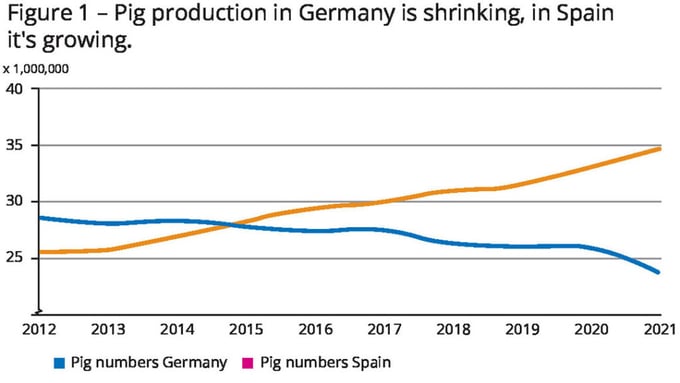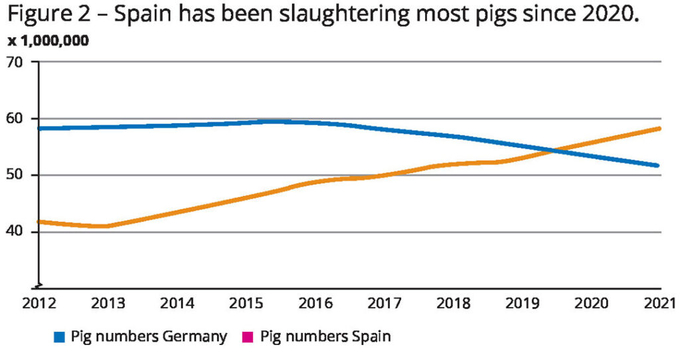November 28, 2025 | 01:02 GMT +7
November 28, 2025 | 01:02 GMT +7
Hotline: 0913.378.918
November 28, 2025 | 01:02 GMT +7
Hotline: 0913.378.918
Now that the industry is being cut back bit by bit, this position is under pressure. Spain’s position, however, is expected to grow. What is going on in Germany?

A piglet and a sow kept together without iron in the farrowing pen. Photo: Henk Riswick
Only 1 decade ago, there was a strong belief that the emphasis of Europe’s pig production would shift to the east – with Germany being a stable, centrally located engine. Fast forward to 2022 and things appear to have been shaken up. Eastern Europe’s pig industry has not proven to be as leading as expected; Germany’s swine industry is shrinking and a new player has emerged in the south: Spain.


34,5 million pigs in Spain
The numbers speak for themselves. In just 10 years, the number of pigs produced in Germany has gone from 28 million to fewer than 24 million pigs (see Figure 1). In the same period, the number of pigs in Spain grew from 25 million to 34.5 million, with pigs in Spain mostly being produced with lower costs and in very efficiently organised integrations. Spain overtook Germany in 2014. Kill numbers were initially still higher in Germany, but since 2020 Germany has lost that leading position as well. Germany decreasing, the number of pigs in Spain growing: that trend has continued ever since (see Figure 2).
Germany affected by ASF
Obviously, Germany was affected by a number of simultaneous developments. African Swine Fever (ASF) caused export problems, leading to a devaluation of German pig meat. That market situation was aggravated by the occurrence of Covid-19. Simultaneously, a renewed focus on welfare (ITW, 5D) may provide additional challenges for some and opportunities for others. The end result is that the German pig industry is shrinking quickly. This happens especially in Eastern Germany, leading to a market situation that verges on self-sufficiency.
In summary, Germany is becoming an inward-looking market, whereas surrounding markets like the Netherlands and Denmark are still focusing on exports, serving European markets as well as the rest of the world.
New European prices
The question is what that new reality means for the importance of Germany’s pig prices. How relevant will that price be? One possible alternative is to keep an eye on the Spanish market, which analists watch with more interest than it was a few years back, by slaughterhouses for instance.
Jan Schuttert is director of pig trading company Schuttert in the Netherlands, and he is very interested in pig prices across Europe. “It is clear that pig prices in key pig countries are converging; Spain as an exporting nation is one of them.”
He acknowledges that Germany’s role is dwindling. “In recent years, Germany negatively influenced price development in surrounding countries. Now the German pig industry is changing fast. We shall have to say goodbye to the German pig price as a major index.” Schuttert says he hopes that eventually there will be one European price.
Future development of Germany
Dr Eva Gocsik, analyst animal protein at Rabobank Food & Agribusiness Research, says further reduction of the German swine inventory is to be expected, by 20–30%. She thinks that the German influence will wane. “The more the German swine industry is shrinking, the less important it will be for pig price development in Europe. Yet it will continue to be a big, important market in Europe.”
She also expects the number of pigs in Spain to continue to grow, especially since pork sales to China have fluctuated in recent years. That is advantageous for Spain, where production prices are generally lower than elsewhere in Europe. She says, “Competing with Spain in terms of volumes will be increasingly difficult.”
(Pig Progress)

(VAN) A new study reveals how the simultaneous effects of ocean acidification, salinity and loss of oxygen are making the world more fragile.

(VAN) Hopes are growing that the creation of the first 3D turkey gut model could be a turning point in the battle against the virulent blackhead disease.

(VAN) Tyson, America’s biggest meat supplier, plans to shutter one of its largest beef processing plants as the industry continues to struggle with low cattle supplies and political pressure from Washington.

(VAN) New FAO study shows how digital solutions are empowering farmers and fishers to prevent losses and build resilient agrifood systems.

(VAN) Brazil's COP30 presidency pushed through a compromise climate deal on Saturday that would boost finance for poor nations coping with global warming but that omitted any mention of the fossil fuels driving it.

(VAN) Poultry farmers in the UK have been warned that they could face one of the worst winters yet for bird flu.

(VAN) Prices of main-crop paddy have risen sharply, with jasmine rice hitting 16,100 baht per tonne — the highest level in years.